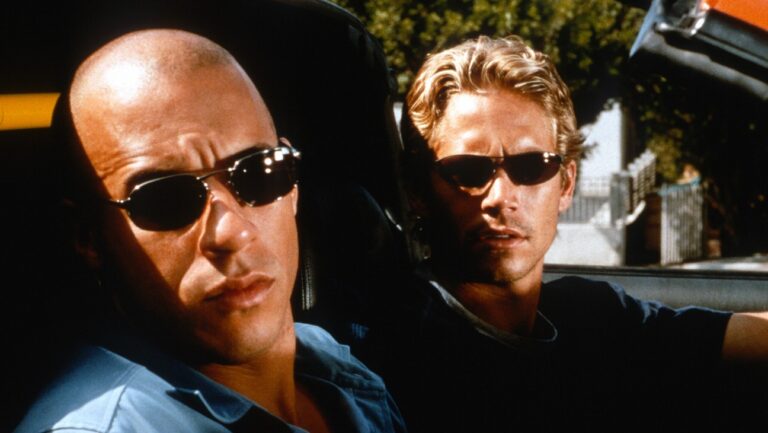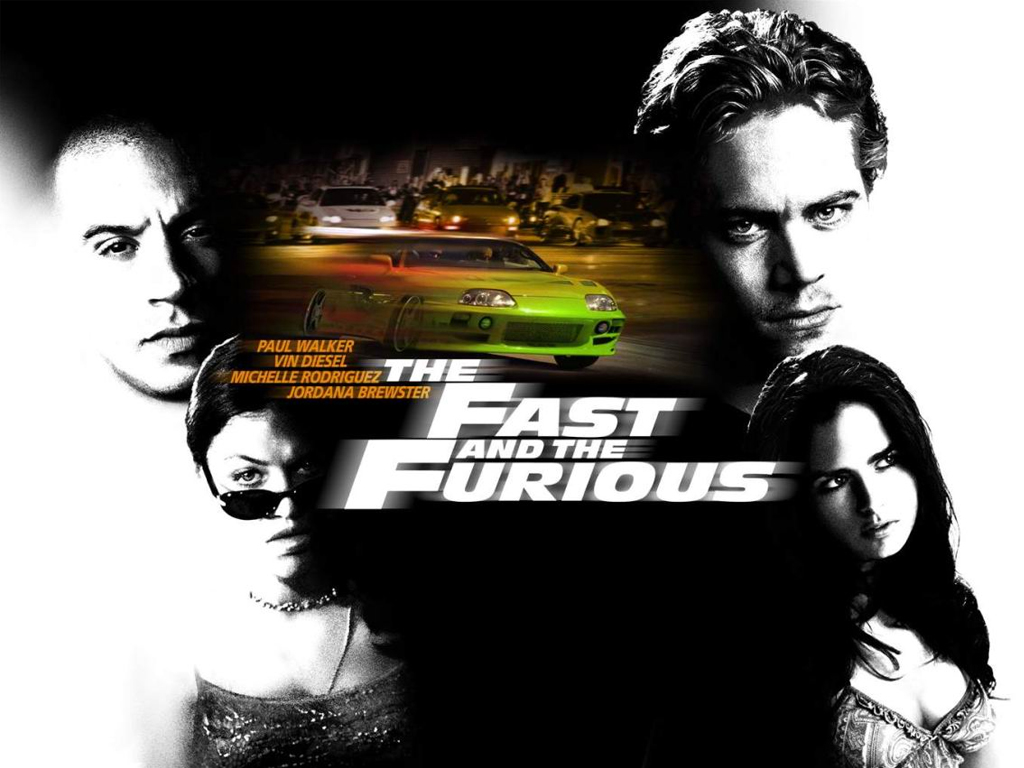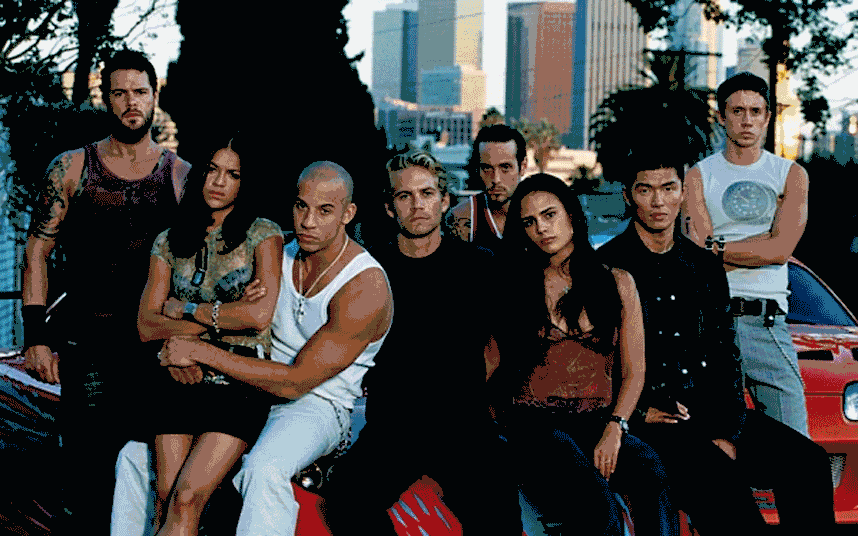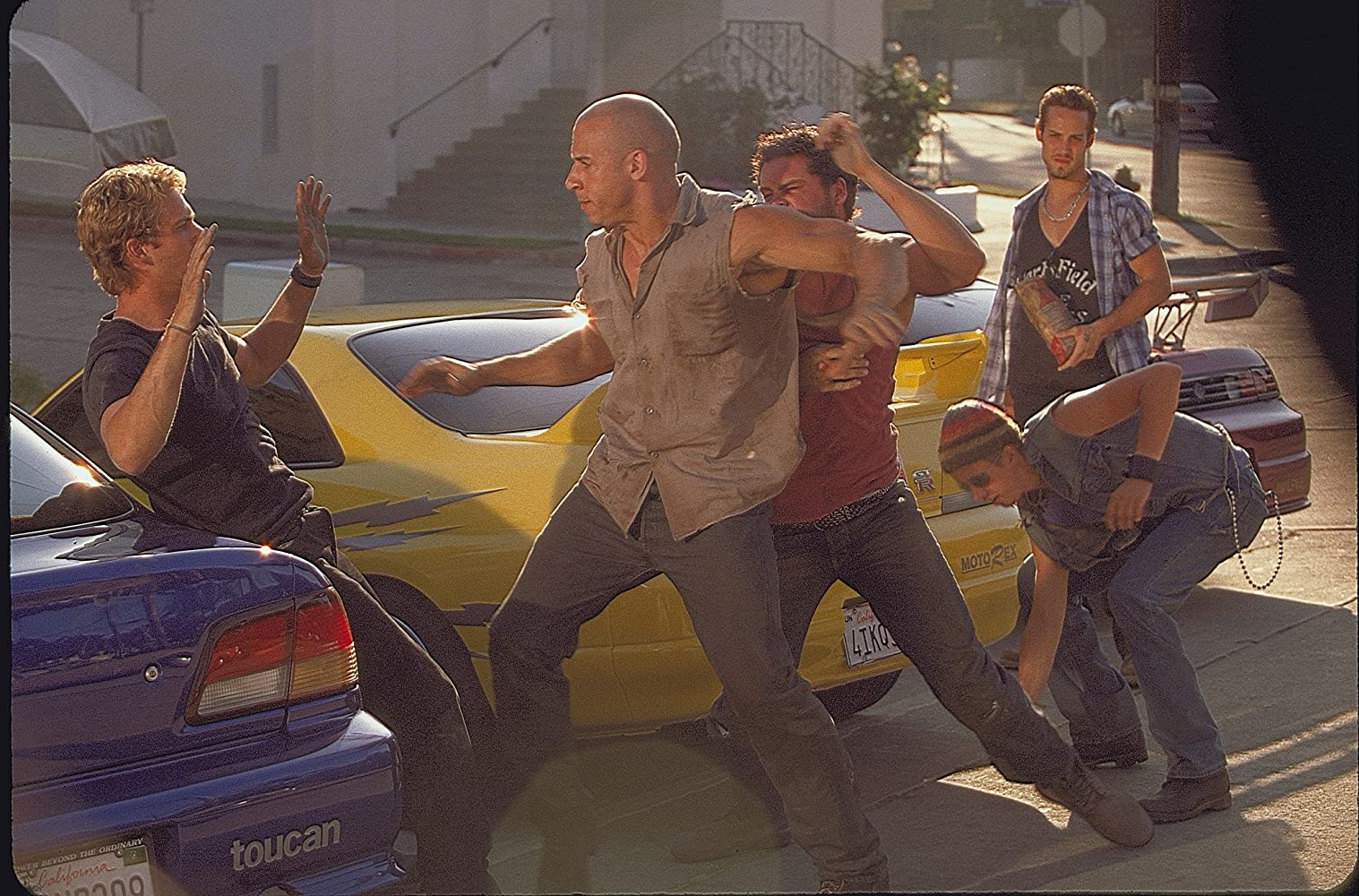
The Prologue to an in-depth analysis of the ultimate action movie exploits of the ‘The Fast Saga‘.

Before men (and women) in spandex and capes ruled the box office there existed the Ultimate Action movie. It’s entries are numerous. It’s heroes’ names live on forever: John Rambo, John McClane, the Terminator. These peak action films cemented the tropes and staples of the Ultimate Action Movies we love today. But as other ultimate action movies and franchises have retired to Hall of Fame status, one franchise continues to carry the torch: The Fast and the Furious.
There’s a movie franchise that’s outlived all manner of cinema trends. It avoided the renewed interest in 3D. It plowed past the increasing appearance of superheroes and dove head first into international cinemas making a name for itself as a rogue entry into franchise territory NOT based on a pre-existing IP. It survived by adapting, by innovating, and mostly by appealing to the lowest common denominator.
Cinephiles decry the franchise as a death blow to cinema calling it a bloated international moneymaker devoid of character or soul. Their criticism is harsh, but refutable. The numbers don’t lie. Despite all odds the Dominic Toretto and his family made a cumulative five billion dollars and confuses critics to this day about it’s ongoing success.
Over the next several weeks I’m going to take a look at every single entry into the nine-part franchise. Mostly because I have nothing better to do for the foreseeable future (thank you Coronavirus) but also so you all don’t have to. I will watch these and witness the growth of this franchise. You see, this franchise means something to my generation. For the entirety of my life there have been F&F movies (long before there were Marvel or DC movies.) They have grown alongside me and occasionally earmarked some of the best summers of my life. I intend to honor them.
The Saga of this family derives its value by adapting consistently with the times and employing common blockbuster tactics to score strong box office gains in each successive entry. It became a marketing machine: churning out DVDs and providing a new summer pop single every time it releases. In fact, the seeds for this global phenomenon start in the very first movie…
Read along on the rest of our Fast Saga coverage with these articles on the other Fast & Furious installments:
- THE LONG AND WINDING ROAD OF ‘THE FAST AND THE FURIOUS’ FRANCHISE
- 2 FAST 2 FURIOUS: EXPLORING THE SEQUEL THAT LAUNCHED AN ULTIMATE FRANCHISE
- AN ULTIMATE LOOK BACK AT ‘THE FAST AND THE FURIOUS: TOKYO DRIFT’
- FAST & FURIOUS: FROM UNDERGROUND STREET RACING TO MAINSTREAM ACTION
- THE INFLUENCE OF VIDEO GAME CULTURE ON THE FAST & FURIOUS FRANCHISE
- FAST FIVE: A NEW ULTIMATE HEIST FRANCHISE EMERGES
- FAST & FURIOUS 6: THE FAST SAGA GOES FULL SUPERHERO ACTION
- PAUL WALKER’S ULTIMATE LEGACY ABOUNDS IN ‘FURIOUS 7’ (2015)
- THE FAST FRANCHISE REACHES ITS FINAL FORM IN ‘THE FATE OF THE FURIOUS’ (2017)
- AN ULTIMATE LOOK AHEAD AT ‘FAST & FURIOUS 9’
- THE ULTIMATE RANKINGS FOR THE ‘FAST & FURIOUS’ FRANCHISE MOVIES
The Long and Winding Road: Chapter 1 – Family
To fairly find this first foray of the Fast & the Furious world we must provide a little context. That summer Fast and the Furious played against films as wide as A Knight’s Tale, Moulin Rouge, The Mummy Returns, and Shrek. The entire budget for the movie cost roughly thirty eight million dollars (to put that in perspective Fast Five cost 125 million dollars!) – the typical price point for mid-range action flicks.
This was June 2001. A national tragedy was still months away. The director of the movie, Rob Cohen, made a name for himself directing episodes of action TV classics like Miami Vice and the fantasy film Dragonheart. We can see in his career that after F&F he deployed his expertise in the action genre with aplomb crafting some hits (xXx, Stealth, Hurricane Heist) and some misses (Mummy: Tomb of the Dragon Emperor and Alex Cross.)
The very first Fast and the Furious functions as something of a throwback to the glory days of action movies – fitting into the template left behind by flicks like Point Break – while hovering on the edge of a new wave of digital cinema. The standard 80’s everyman hero grafted perfectly onto Paul Walker’s Brian O’Connor while the early aughts anti-hero finds its place in Vin Diesel.
Inspired by a 1998 Vibe article titled ‘Racer-X’ the first Fast and the Furious begins as a somewhat convoluted tale of cops and criminals. Paul Walker stars as Brian O’Connor, an eager-eyed wannabe street racer working in a garage. He tries to get in tight with the king of LA’s underground racing scene, Dominic Toretto. Dom and his crew don’t trust O’Connor, but Dom’s little sister Mia (Jordana Brewster) might have a crush on him. MEANWHILE, someone keeps stealing from eighteen-wheelers using elaborate mid-traffic heists. It’s basically, the entire plot of Point Break but with street racing instead of extreme sports. Swap Keanu with Paul Walker and Swayze with Diesel.
Paul Walker, Vin Diesel and the F&F Crew

The movie stands as much a product of it’s time as another foray into ever-so-meaningless action. But the beginning of the Fast and the Furious’s own, unique franchise identity crop up from the start: high-octane stunts, cheesy one-liners, a current soundtrack, slightly naked women, and a bizarre emphasis on family despite the 150 mph plot. Let’s break those down.
The stunts in this movie are almost exclusively high-speed street racing. While cars whizz and blur past each other, a barrage of sound effects help sell the noise of a car accelerating into infinity. The races happen like any action sequence: quick cuts between cars (enough to maintain some semblance of geography), inserts of the actors reacting, and a gag here or there. The cars – apparently over sixty Japanese vehicles – take center stage with elaborate dressing and vibrant colors. (In fact, the production designer asked blocks of LA residents to paint their houses drab colors so the cars might stand out more.) In a 2000’s-era spike of genius Cohen added a digital sequence where the camera dives into the car’s engines just when someone pushes the NOS button. Digital flames shoot past the lens and pistons explode in an effort to go faster. Sure these effects have not aged well, but they’re a sign of the oncoming digital era.
The one-liners are something of an artifact harking back to the golden lines of the 80’s. Very few lines rarely ever land perfectly (“I’ll be back” or “Yippee-ki-yay!”) so it’s no surprise the general movie going audience finds these to be droll or juvenile. Still, the first entry delivers on the number one line of the entire franchise “I live my life a quarter mile at a time.” Dom pontificates to Brian O’Connor after a particularly hairy run-in with the police. It’s a line that would come to define the franchise’s mentality about action.
One of the biggest selling points of any F&F movie is it’s soundtrack. Who can forget Wiz Khalifa and 2 Chainz’ triumphant “We Own It” from Fast & Furious 6 or the reggaeton smash hit ‘Danza Kuduro’ by Don Omar? The films – much like the Bond franchise – often become arbiters of taste with at least one of their soundtrack songs one of the marquee soundtrack songs moving onto radio stations and to the top of summer charts. (Just take Charlie Puth’s “See You Again” from Furious 7 which became the hallmark song of high school graduation in 2017, cheesy or not. )
The first movie is no different, giving us classics like Ja Rule’s “Furious” or the quintessential “Rollin’ (Urban Assault Vehicle)” from all star lineup of Limp Bizkit, Method Man, Redman, Swizz Beatz, and DM Freakn’ X. These songs place us firmly in the South L.A. culture and anchor us in a “street” aesthetic most white audiences don’t know. These songs place us firmly in South L.A.’s culture and anchor us in a street aesthetic most white audiences aren’t familiar with.
Bloodshot: Vin Diesel as the Ultimate Action Movie Superhero
How Ultimate Was the Original Really?

F&F’s PG-13 rating prevented it from ever dabbling in raw nudity but the amount of clothing available to the women at street racing contests apparently borders on wildly inappropriate. This would be a running bit every entry afterward would cling to, despite outgrowing the need for it. Yes, they sexed up street racing parties. Forever after, whenever Dom and Bryan would hit up a local street race (whether it be in Cuba, Rio, Tokyo, London, Dubai, etc.) there would always be women in booty shorts and tube tops. It’s one of the few elements the franchise could do away with but constantly chooses not to, largely to appeal to it’s one quadrant male audience members who drive box office profit.
The most important thing to this whole franchise is it’s odd emphasis on characters. For an action movie there’s plenty of plot, sure, but a surprising amount of character growth. This movie delves more into the character’s relationships as they grow and change setting it apart from another racing movie, Gone in Sixty Seconds.
This movie attempts to give breathing room to Diesel, Walker, Lindberg, Rodriguez, et al to perform. It’s an odd choice given that they have all the elements they need to be successful. It’s a choice that almost sets the movie back a bit, but this focus ultimately helps develop the strong theme of ‘family’ that carries this entire franchise. It’s not about cops and robbers. It’s about the ties that bind this band of misfits.
The first entry is a hodge-podge of movie moments. It’s got your quippy one-liners and your macho man brawling. It carries hints of LA gangland drama. It skims over the cop versus criminal aesthetic in favor of a more subdued family drama – when it’s not roaring it’s engine at us. It’s unsightly at first watch, dangly and awkward. It employs old CGI to make the cars feel faster when it could’ve showed us more stunt work. Still, all the things that make The Fast and the Furious what it is exist here in prototype form. The fact that these old tie overs still inform the franchise nine movies later only speaks to some weird Promethean ability of the first film.
When this movie came out it earned over one hundred and thirty million dollars in domestic box office alone, well over three times its budget. It has its own ride at Universal Studios theme park in Orlando. It’s stars are international icons now. It all started with a small tale of a couple of robbers in South L.A. trying to supplement their racing with a dangerous side gig. America’s most international family started in the halls of a two-story house on cement blocks filled with people who only drink corona. Oh! And if you touch the food first, you pray. That’s tradition and if there’s one thing we learn the movie loves, it’s tradition.